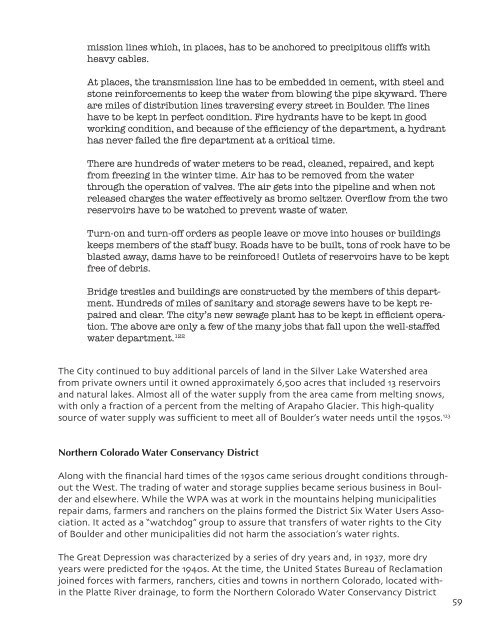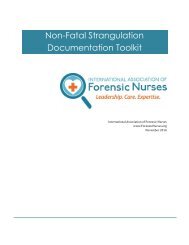Create successful ePaper yourself
Turn your PDF publications into a flip-book with our unique Google optimized e-Paper software.
mission lines which, in places, has to be anchored to precipitous cliffs with<br />
heavy cables.<br />
At places, the transmission line has to be embedded in cement, with steel and<br />
stone reinforcements to keep the water from blowing the pipe skyward. There<br />
are miles of distribution lines traversing every street in Boulder. The lines<br />
have to be kept in perfect condition. Fire hydrants have to be kept in good<br />
working condition, and because of the efficiency of the department, a hydrant<br />
has never failed the fire department at a critical time.<br />
There are hundreds of water meters to be read, cleaned, repaired, and kept<br />
from freezing in the winter time. Air has to be removed from the water<br />
through the operation of valves. The air gets into the pipeline and when not<br />
released charges the water effectively as bromo seltzer. Overflow from the two<br />
reservoirs have to be watched to prevent waste of water.<br />
Turn-on and turn-off orders as people leave or move into houses or buildings<br />
keeps members of the staff busy. Roads have to be built, tons of rock have to be<br />
blasted away, dams have to be reinforced! Outlets of reservoirs have to be kept<br />
free of debris.<br />
Bridge trestles and buildings are constructed by the members of this department.<br />
Hundreds of miles of sanitary and storage sewers have to be kept repaired<br />
and clear. The city’s new sewage plant has to be kept in efficient operation.<br />
The above are only a few of the many jobs that fall upon the well-staffed<br />
water department. 122<br />
The City continued to buy additional parcels of land in the Silver Lake Watershed area<br />
from private owners until it owned approximately 6,500 acres that included 13 reservoirs<br />
and natural lakes. Almost all of the water supply from the area came from melting snows,<br />
with only a fraction of a percent from the melting of Arapaho Glacier. This high-quality<br />
source of water supply was sufficient to meet all of Boulder’s water needs until the 1950s. 123<br />
Northern Colorado Water Conservancy District<br />
Along with the financial hard times of the 1930s came serious drought conditions throughout<br />
the West. The trading of water and storage supplies became serious business in Boulder<br />
and elsewhere. While the WPA was at work in the mountains helping municipalities<br />
repair dams, farmers and ranchers on the plains formed the District Six Water Users Association.<br />
It acted as a “watchdog” group to assure that transfers of water rights to the City<br />
of Boulder and other municipalities did not harm the association’s water rights.<br />
The Great Depression was characterized by a series of dry years and, in 1937, more dry<br />
years were predicted for the 1940s. At the time, the United States Bureau of Reclamation<br />
joined forces with farmers, ranchers, cities and towns in northern Colorado, located within<br />
the Platte River drainage, to form the Northern Colorado Water Conservancy District<br />
59



